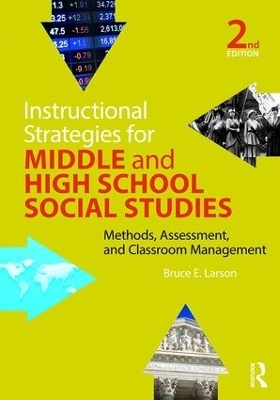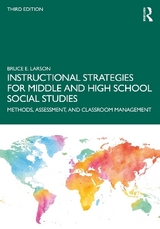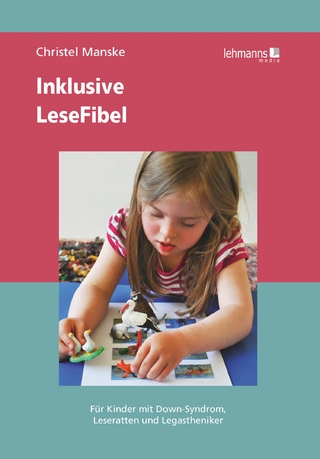
Instructional Strategies for Middle and High School Social Studies
Methods, Assessment, and Classroom Management
Seiten
2016
|
2nd edition
Routledge (Verlag)
978-1-138-84678-4 (ISBN)
Routledge (Verlag)
978-1-138-84678-4 (ISBN)
Zu diesem Artikel existiert eine Nachauflage
Instructional Strategies for Middle and High School Social Studies: Methods, Assessment, and Classroom Management is an exciting methods-based text that integrates appropriate management and assessment techniques with seven distinct teaching strategies. Writing explicitly for pre-service social studies teachers, veteran teacher educator Bruce E. Larson offers detailed descriptions of a range of instructional strategies, along with guidelines for deciding how and when to use each.
Part I offers the foundations for teaching and learning in a social studies classroom, and explores contextual, theoretical, and policy factors that all teachers need to consider before entering the classroom. Part II delivers a range of comprehensive strategies for providing instruction that is appropriate for particular lessons, student abilities, and classroom environments. The practical strategies in Part II build upon the learning theories described in Part I, positioning Instructional Strategies for Middle and High School Social Studies to be the go-to, all-inclusive teacher’s guide to the social studies classroom.
New to this Edition
A list of goals before each chapter presents an overview of the chapter’s content focus, and provides an outline for the chapter review.
Extensively revised Part I (chapters 1–4) provides an updated review of national standards developed for teaching history, geography, civics, and economics. In-depth applications of the Common Core State Standards for the social studies are also explored.
New "Reality Check" feature provides directions for integrating field-based experiences into the chapters, and contextualizes the ideas in the book for a classroom setting.
Each chapter in Part II (chapters 5–11) has been expanded to include a section labeled "Enhancing Student Learning with Technology," offering websites, links, and other resources for integrating recent technologies into the classroom.
Chapters 5–11 include a new "Making Your Lesson More Meaningful for ELLs" feature, which provides ideas—based on current research and theories about learning language—for engaging ELLs, specific for each instructional strategy.
Expanded discussion of the "Understanding by Design" model equips teachers to design learning experiences that promote student understanding by intentionally designing what happens in the classroom, and developing authentic formative assessments of student learning.
Part I offers the foundations for teaching and learning in a social studies classroom, and explores contextual, theoretical, and policy factors that all teachers need to consider before entering the classroom. Part II delivers a range of comprehensive strategies for providing instruction that is appropriate for particular lessons, student abilities, and classroom environments. The practical strategies in Part II build upon the learning theories described in Part I, positioning Instructional Strategies for Middle and High School Social Studies to be the go-to, all-inclusive teacher’s guide to the social studies classroom.
New to this Edition
A list of goals before each chapter presents an overview of the chapter’s content focus, and provides an outline for the chapter review.
Extensively revised Part I (chapters 1–4) provides an updated review of national standards developed for teaching history, geography, civics, and economics. In-depth applications of the Common Core State Standards for the social studies are also explored.
New "Reality Check" feature provides directions for integrating field-based experiences into the chapters, and contextualizes the ideas in the book for a classroom setting.
Each chapter in Part II (chapters 5–11) has been expanded to include a section labeled "Enhancing Student Learning with Technology," offering websites, links, and other resources for integrating recent technologies into the classroom.
Chapters 5–11 include a new "Making Your Lesson More Meaningful for ELLs" feature, which provides ideas—based on current research and theories about learning language—for engaging ELLs, specific for each instructional strategy.
Expanded discussion of the "Understanding by Design" model equips teachers to design learning experiences that promote student understanding by intentionally designing what happens in the classroom, and developing authentic formative assessments of student learning.
Bruce E. Larson is Professor of Secondary Education and Social Studies at Western Washington University.
Introduction
PART 1: Foundations for Teaching and Learning Social Studies
Chapter 1: The Social Studies
Chapter 2: The Learner, and The Classroom Learning Community
Chapter 3: Preparing Learning Targets and Assessing Student Learning
Chapter 4: Long And Short Range Planning
PART 2: Instructional Strategies For Social Studies
Chapter 5: Lecture And Interactive Presentations
Chapter 6: Questioning
Chapter 7: Concept Formation
Chapter 8: Cooperative Learning
Chapter 9: Simulations, Role-Play, And Dramatization
Chapter 10: Discussion and Debate
Chapter 11: Inquiry and Student-Directed Investigations
| Erscheinungsdatum | 24.05.2016 |
|---|---|
| Zusatzinfo | 11 Tables, black and white; 20 Line drawings, black and white |
| Verlagsort | London |
| Sprache | englisch |
| Maße | 178 x 254 mm |
| Gewicht | 602 g |
| Themenwelt | Schulbuch / Wörterbuch |
| Sozialwissenschaften ► Pädagogik ► Schulpädagogik / Grundschule | |
| ISBN-10 | 1-138-84678-3 / 1138846783 |
| ISBN-13 | 978-1-138-84678-4 / 9781138846784 |
| Zustand | Neuware |
| Haben Sie eine Frage zum Produkt? |
Mehr entdecken
aus dem Bereich
aus dem Bereich
für Kinder mit Down-Syndrom, Leseratten und Legastheniker
Buch | Softcover (2023)
Lehmanns Media (Verlag)
19,95 €
Grundlagen und Praxis
Buch | Softcover (2022)
Beltz (Verlag)
19,95 €
wie Lehrer, Eltern und Schüler guten Unterricht gestalten
Buch | Softcover (2024)
Klett-Cotta (Verlag)
24,00 €



